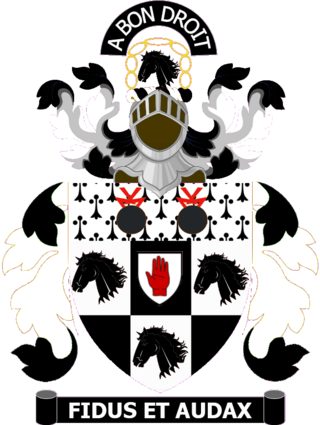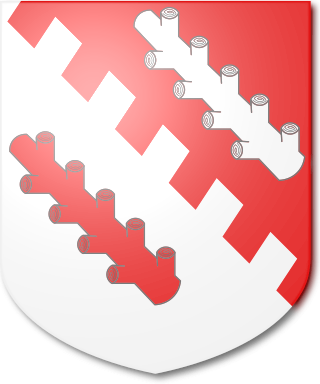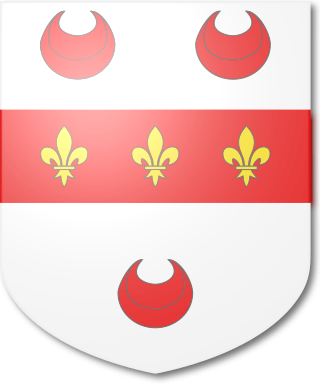
The Hobhouse Baronetcy, of Chantry House in the parish of Bradford-on-Avon in the County of Wiltshire and of Westbury College in the County of Gloucester, is a title in the Baronetage of the United Kingdom. It was created on 22 December 1812 for Benjamin Hobhouse, a wealthy brewer and member of parliament for Bletchingley, Grampound and Hendon. His eldest son, the second Baronet, was a prominent writer and Liberal politician and notably served as Chief Secretary for Ireland and as President of the Board of Control. In 1851 he was raised to the peerage as Baron Broughton, of Broughton-de-Gyffard in the County of Wiltshire. However, he had no sons and on his death the barony became extinct, while he was succeeded in the baronetcy by his nephew, the third Baronet. The latter's son, the fourth Baronet, was also a noted Liberal politician and held office as Chancellor of the Duchy of Lancaster and as Postmaster General.

The Strachey baronetcy, of Sutton Court in the County of Somerset, England, is a title in the Baronetage of the United Kingdom. This family was originally seated at Walden, Essex, where William Strachey was living under the rule of Edward VI. Later they moved to Surrey and at last settled at Sutton Court, Somerset. The title was created on 15 June 1801 for the politician and civil servant Henry Strachey. Sir Henry was private secretary to Lord Clive during his last expedition to India in 1764. He also took part in negotiations for peace with North America where he assisted the kings commissioners at Paris. He died in 1809 and was succeeded by his eldest son Henry, the second Baronet Strachey. His great-grandson, the fourth Baronet, was a Liberal politician. On 3 November 1911, he was created Baron Strachie, of Sutton Court in the County of Somerset, in the Peerage of the United Kingdom. He later served as Paymaster General. The peerage became extinct on the death of his son, the second Baron, in 1973. The baronetage is currently dormant.
The Redmayne Baronetcy of Rushcliffe in the County of Nottingham, is a title in the Baronetage of the United Kingdom. It was created on 29 December 1964 for the Conservative politician Martin Redmayne. In 1966 he was created a life peer as Baron Redmayne, of Rushcliffe in the County of Nottingham, in the Peerage of the United Kingdom. The life peerage became extinct on his death in 1983 while he was succeeded in the baronetcy by his son, the second Baronet. As of 2010 the title is held by the latter's son, the third Baronet, who succeeded in 2008.

The Slade Baronetcy, of Maunsel House in the County of Somerset, is a title in the Baronetage of the United Kingdom. It was created on 30 September 1831 for General Sir John Slade, a Peninsular War veteran. The second Baronet was a lawyer. The third Baronet served as Receiver-General of Inland Revenue.

The Anson baronetcy, of Birch Hall in the County Palatine of Lancaster, is a title in the Baronetage of the United Kingdom held by a branch of the Anson family.

There have been two baronetcies created for persons with the surname Backhouse, once in the Baronetage of England and once in the Baronetage of the United Kingdom. As of 2023 one creation is extant.

The Boyle Baronetcy, of Ockham in the Parish of Salehurst in the County of Sussex, is a title in the Baronetage of the United Kingdom. It was created on 14 December 1904 for Edward Boyle, a barrister, businessman and Conservative Member of Parliament for Taunton. His grandson, the third Baronet, was also a Conservative Member of Parliament and ultimately cabinet minister serving as Minister of Education from 1962 to 1964. He was made a life peer as Baron Boyle of Handsworth, of Salehurst in the County of Sussex, in 1970 and became vice-chancellor of the University of Leeds in the same year. The life peerage became extinct on his death in 1981 and he was succeeded in the baronetcy by his younger brother, the fourth Baronet. As of 2025 the title is held by the latter's eldest son, the fifth Baronet, who succeeded in 1983.

There have been two baronetcies created for members of the Whitmore family, one in the Baronetage of England and one in the Baronetage of the United Kingdom. One creation is extinct while the other is extant.

The de Capell-Brooke Baronetcy, of Oakley in the County of Northampton, was a title in the Baronetage of the United Kingdom. It was created on 20 June 1803 for Richard de Capell-Brooke, a bencher of the Inner Temple and for 30 years a Colonel of the Northamptonshire Militia. Born Richard Supple, he was the son of Richard Supple, of Ahadoe, who in the 1750s married Mary, daughter of Arthur Brooke, of Great Oakley, Northamptonshire. In 1797 he inherited the Great Oakley estate from his great-uncle, Wheeler Brooke, and assumed at that time by sign manual and in obedience to the testamentary injunction of his great-uncle the surname Brooke as well as the original surname of his family, de Capell. He was succeeded by his eldest son, the second Baronet, who was a noted travel writer and Fellow of the Royal Society. The fifth Baronet was High Sheriff of Rutland in 1899, a deputy lieutenant of Northamptonshire and a justice of the peace and also unsuccessfully stood three times for the parliamentary seat of East Northamptonshire. On 4 July 1939 he was elevated to the Peerage of the United Kingdom as Baron Brooke of Oakley, of Oakley in the County of Northampton. The barony became extinct on his death in 1944 while he was succeeded in the baronetcy by Sir Edward de Capell-Brooke, the fifth Baronet. The baronetcy became extinct on the latter's death in 1968.

There have been two baronetcies created for the Guise family, one in the Baronetage of England and one in the Baronetage of Great Britain. The latter creation is extant as of 2014.
The Greenaway Baronetcy, of Coombe in the County of Surrey, is a title in the Baronetage of the United Kingdom. It was created on 23 October 1933 for Percy Walter Greenaway. He was Chairman of Daniel Greenaway & Sons, printers and stationers, and served as Lord Mayor of London from 1932 to 1933. As of 2015 the title is held by his great-grandson, the fourth Baronet, who succeeded his father in that year.
There have been four baronetcies created for persons with the surname Bell, all in the Baronetage of the United Kingdom. One creation is extant as of 2007.

The Wrixon-Becher Baronetcy, of Ballygiblin in the County of Cork, is a title in the Baronetage of the United Kingdom. It was created on 30 September 1831 for William Wrixon-Becher, Member of Parliament for Mallow from 1818 to 1826. Born George Wrixon, he assumed by Royal licence his mother's maiden surname of Becher in 1831. The Becher family were major landowners in County Cork.

The Oakeley Baronetcy, of Shrewsbury, is a title in the Baronetage of Great Britain. It was created on 5 June 1790 for the Indian administrator Charles Oakeley. He served as Governor of Madras from 1790 to 1794. Frederick Oakeley was the second son of the first Baronet.

The Medlycott Baronetcy, of Ven House in the County of Somerset, was a title in the Baronetage of the United Kingdom. It was created on 3 October 1808 for William Medlycott, Member of Parliament for Milborne Port from 1790 to 1791. The family descended from James Medlycott, of Ven House, who represented Milborne Port in the House of Commons between 1710 and 1722. His son Thomas Medlycott died without surviving male issue in 1763 and left his estates to his maternal nephew Thomas Hutchings, who adopted the surname of Medlycott. His son was the first Baronet. The baronetcy became extinct with the death of the 9th Baronet in 2021.
The Hartwell Baronetcy, of Dale Hall in the County of Essex, is a title in the Baronetage of the United Kingdom. It was created on 26 October 1805 for Admiral Francis Hartwell.
There have been two baronetcies created for persons with the surname Gibbons, one in the Baronetage of Great Britain and one in the Baronetage of the United Kingdom. One creation is extant as of 2012.
The Jervoise, later Clarke-Jervoise Baronetcy, of Idsworth in the County of Southampton, was a title in the Baronetage of the United Kingdom. It was created on 13 November 1813 for Rev. Samuel Jervoise, born Samuel Clarke, who assumed the surname of Jervoise by royal licence in 1808.

The Key baronetcy, of Thornbury in the County of Gloucester and of Denmark Hill in the County of Surrey, was a title in the Baronetage of the United Kingdom. It was created on 17 August 1831 for John Key, Lord Mayor of London between 1830 and 1831. The title became extinct on the death of the 4th Baronet in 1932.

The Harty Baronetcy, of Prospect House in Roebuck in the County of Dublin, was a title in the Baronetage of the United Kingdom. It was created on 30 September 1831 for Robert Harty, Lord Mayor of Dublin. The title became extinct on the death of the fourth Baronet in 1939.














